- within Employment and HR topic(s)
- in United States
- within Transport, Litigation, Mediation & Arbitration and Privacy topic(s)
Duane Morris Takeaways: In FY 2025(October 1, 2024 to September 30, 2025), the EEOC's litigation enforcement activity stalled significantly compared to previous years. By the numbers, FY 2025 lawsuit filings ended on the lower end of the spectrum with 94 lawsuits filed compared to the height of filings in FY 2018 (217 lawsuits). The decline in enforcement activity suggests that during President Trump's second term in office, employers should not expect the EEOC to be as aggressive as past regimes in terms of the volume of government enforcement lawsuits, particularly in terms of systemic litigation.
Though the overall filings totals are lower than previous years, certain geographic regions, types of claims, and key industries remain prime targets of the Commission's lawsuits. Our analysis of these patterns is set forth below and is offered to arm employers with the EEOC's FY 2025 litigation scorecard through an evaluation of district office enforcement activity, filings by statute and discrimination basis, and the most impacted industries.
In sum, there is still a bevy of EEOC lawsuits being filed against businesses, but in a more localized and targeted fashion. Employers should continue their legal compliance with all EEOC initiatives.
Lawsuit Filings Based On Month And Year
The EEOC's fiscal year ends each year on September 30. The final deluge of filings for EEOC-initiated litigation maintained its year-end boost in 2025. This year, in September alone, 35 lawsuits were filed, down from September filings in FY 2024 (50 lawsuits filed) and September filings in FY 2023 (67 lawsuits filed) – but still a significant total, nonetheless. Of the 94 total filings this year, just over one-third of EEOC lawsuits were filed in September, down from FY 2024's last-minute filing frenzy accounting for half of that year's filings. The following chart shows the EEOC's filing pattern over FY 2025:
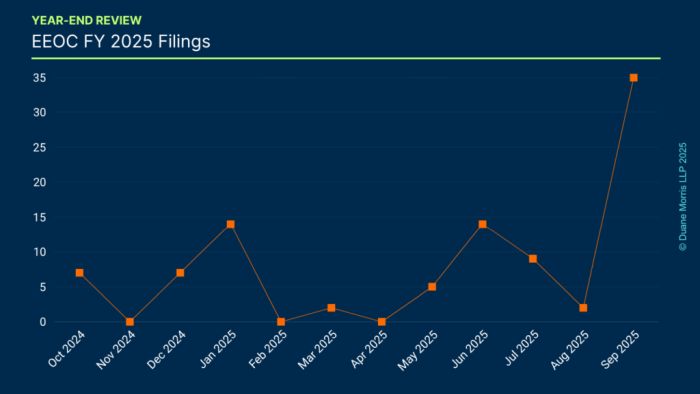
We track the EEOC's filing efforts across the entire fiscal year with its beginning in October through the anticipated filing spree in September. Unlike other fiscal years, the EEOC's filing patterns were consistent in the first half of FY 2025, peaking with 14 lawsuits in January. Filings again slowed down until Summer, where there was a resurgence of another 14 lawsuits in June 2025. Thereafter, lawsuit filings dipped until the "eleventh hour" in September.
Comparing these filings in FY 2025 to previous years, the EEOC filed significantly less lawsuits than in FY 2024 (111) and FY 2023 (144 lawsuits), signaling a trend in decreased EEOC enforcement activity. Though EEOC litigation filings continuously decreased compared to pre-COVID era filing metrics, the EEOC's presence as a litigation powerhouse persists. The following graph shows the EEOC's year-over-year fiscal year filings beginning in FY 2017 through FY 2025:
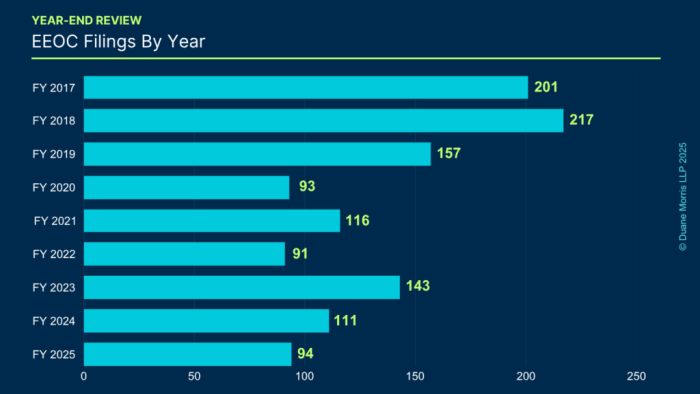
Lawsuit Filings Based On EEOC District Offices
In addition to tracking the total number of filings, we closely monitor which of the EEOC's 15 district offices are most actively filing new cases throughout the EEOC's fiscal year. Some district offices tend to be more aggressive than others. Some focus on different case filing priorities. The following chart shows the number of lawsuit filings by each of the EEOC district offices.
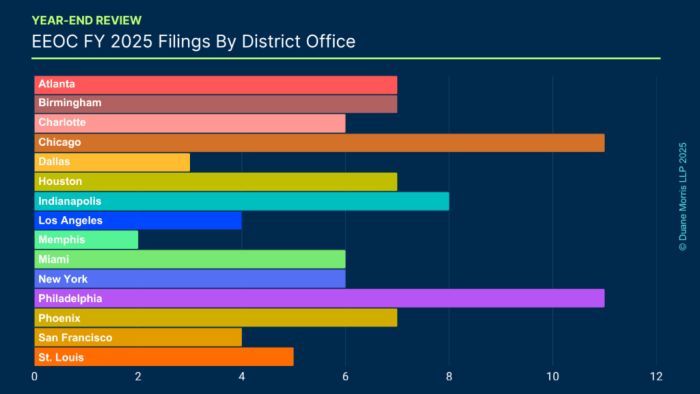
In FY 2025, Philadelphia and Chicago led the pack in filing the most lawsuits at 11 each, followed by Indianapolis with 8 filings, then Atlanta, Birmingham, Houston, and Phoenix with 7 filings, and Charlotte, New York, and Miami each with 6 filings. St. Louis had 5 filings, Los Angeles and San Francisco had 4 filings, and Dallas had 3 filings. Memphis had the lowest amount with only 2 filings.
Like FY 2024, Philadelphia proved itself as a leader in EEOC enforcement filings. Chicago remained steady with 11 filings, same as FY 2024. St. Louis (2 filings in FY 2024) and Phoenix (4 filings in FY 2024) also experienced increases in filings compared to last year. Other offices comparatively lagged in enforcement activity, Atlanta (11 filings in FY 2024), Indianapolis (9 filings in FY 2024), and Houston (8 filings in FY 2024), showed slight decreases in enforcement activities. Across the board filings generally evened out for each district office compared to FY 2024, but overall, filings fell.
Although filing trends were down for all Districts, the total filings demonstrate the EEOC maintained its consistent litigation strength, across all district offices. Employers with operations in Philadelphia and Chicago should pay extra attention to EEOC charge activity given the aggressiveness of the Commission in those regions.
(Note: Three EEOC press releases from the Washington D.C. Field Office included their lawsuit filings as part of the Philadelphia District Office statistics)
Lawsuit Filings Based On Type Of Discrimination
We also analyze the types of lawsuits the EEOC filed in terms of the statutes and theories of discrimination alleged. This enables us to determine how the EEOC is shifting its strategic priorities.
When considered on a percentage basis, the distribution of cases filed by statute skewed significantly in favor of Title VII cases when comparing FY 2025 to previous fiscal years. Title VII cases once again made up the majority of cases filed, as they constituted 50% of all filings in FY 2025 (decreased from 58% of all filings in FY 2024, significantly down from 68% of all filings FY 2023 and 69% of filings in FY 2022, and decreased compared to 61% of all filings in FY 2021).
Overall, ADA cases also made up the next most significant percentage of the EEOC's FY 2025 filings – totaling 31.5%. This is an overall decrease in previous years where ADA filings amounted to 42% in FY 2025, 34% in FY 2023, and 37% in FY 2021. Though these filings are marginally higher than FY 2022 where ADA filings on a percentage basis amounted to 29.7% of all filings.
There was also an uptick in ADEA filings, as 9 ADEA cases were filed in FY 2025, whereas 6 age discrimination cases were filed in FY 2024, after 12 age discrimination cases were filed in FY 2023 and 7 age discrimination cases were filed in FY 2022. Like FY 2024, this year the EEOC pursued Pregnant Worker's Fairness Act cases with 6 filings compared to FY 2024's 3 filings. In addition, FY 2025 had a slight increase in Pregnancy Discrimination Act cases where 5 cases were filed compared to FY 2024's 4 filed cases. Notably absent from FY 2025's filing balance are cases under the Equal Pay Act and Genetic Information Nondiscrimination Act. The following graph shows the number of lawsuits filed according to the statute under which they were filed.
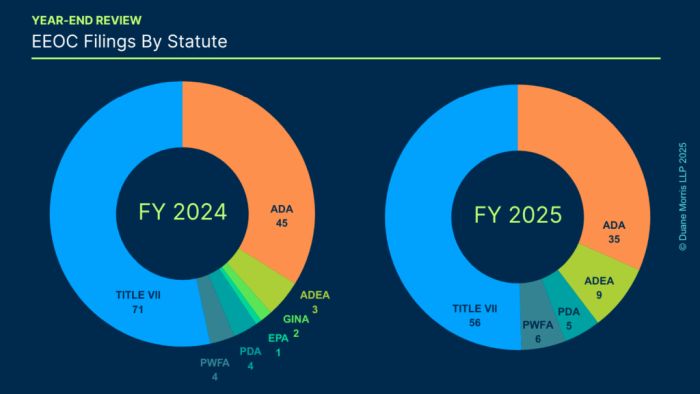
We also collect data on the allegations for which the EEOC bases its litigation filing.
The EEOC's basis for suit remained the same among its core tenets, with Disability, Sex, and Retaliation claims leading the way. Collectively, these three bases were alleged in 59.4% of FY 2025 EEOC filings. In FY 2024, those same three core tenets also took the top three spots (collectively alleged in 67.6% of FY 2024 EEOC filings). Notably, in FY 2025, only 3 Race or National Origin based lawsuits were filed by the EEOC, or 2.3% of the total lawsuit filings. In FY 2024, 8.9% of all filings included Race claims. The following graph shows a comparison of the filings in FY 2025 to FY 2024 for the allegation basis in filings:
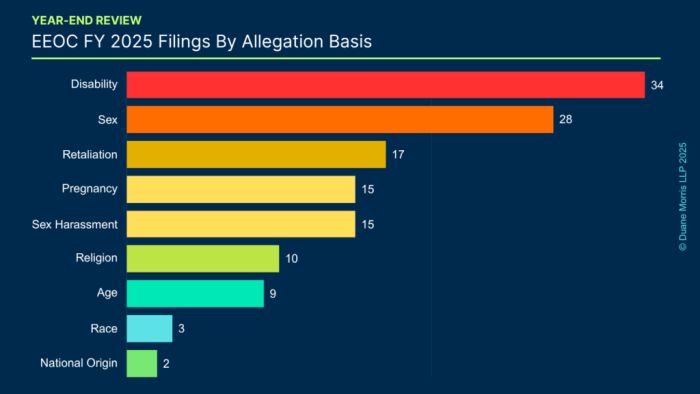
Lawsuits Filings Based On Industry
In monitoring the EEOC's filings by industry, FY 2025 aligns with prior EEOC-initiated lawsuits in the top two industries compared to FY 2024, demonstrating the Commission's focus on a few major industries.
In FY 2025, two industries remained in the EEOC's targets: Hospitality and Healthcare: On a percentage basis, Hospitality (Restaurants / Hotels / Entertainment) comprised 25% of filings, and Healthcare had 21.3% of filings. A key difference in FY 2025 compared to FY 2024 is Manufacturing (15% of FY 2025 filings; 12.1% of FY 2024 filings) overtaking Retail (11.3% of FY 2025 filings; 23.1% of FY 2024 filings) as the next most targeted industry. The staggering drop in enforcement actions against Retailers poses a distinct drop in enforcement actions in this industry. Only one other industry, Transportation & Logistics, entered double digit enforcement activity (with 10%).The remaining industries in FY 2025 did not enter double-digit percentages though Staffing and Construction each experienced EEOC initiated litigation in FY 2025 (8.8%, and 8.8% of filings respectively per industry).
Unlike FY 2024, FY 2025 did not have any actions which involved Property Management industries. Overall, the FY 2025 industry spread aligns with FY 2024, where Hospitality and Healthcare are the most heavily targeted industries. Though Manufacturing and Retail swapped positions in enforcement priority, both still placed in the third and fourth impacted industries. Like FY 2024, the EEOC's FY 2025 fiscal year again did not advance any industry-based filings in the Automotive, Security, and/or Technology industries.
Like FY 2024, Hospitality and Healthcare employers should continue to monitor their compliance with federal anti-discrimination laws. These industries are regular hotbeds for charges and ultimately lawsuits. No matter the industry, every employer should recognize they are vulnerable to EEOC-initiated litigation as detailed by the below graph.
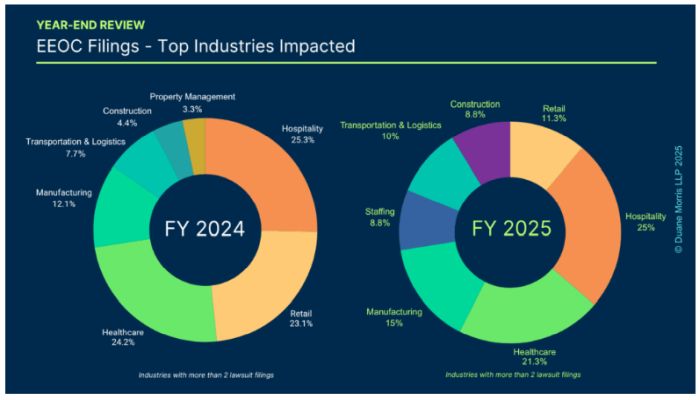
Looking Ahead To Fiscal Year 2026
Moving into FY 2026, the EEOC's budget justification includes a $19.618 million decrease from FY 2025. President Trump's Administration prioritizes a return to the "agency's true mission." The reinvigorated EEOC aims to "return to its founding principles and restore evenhanded enforcement of employment civil rights laws on behalf of all Americans." The EEOC's mission is guided by the President's pledge to "restore dignity to the American worker" and is bolstered by the President's series of executive orders.
The FY 2026 EEOC budget justification signals a transition to "attacking all forms of race discrimination, including rooting out unlawful race discrimination arising from DEI programs, policies, and practices; protecting American workers from unlawful national origin discrimination involving preferences for foreign workers; defending women's sex-based rights at work; and supporting religious liberty by protecting workers from religious bias and harassment and protecting their rights to religious accommodations at work." The Commission also intends to continue its efforts in incorporating technological advances, streamlining and improving operational processes, and refining its organizational structure to ensure efficiency and effective EEOC enforcement.
The EEOC also shifted its goals in FY 2025. The EEOC now prioritizes three strategic goals. First, the EEOC will combat and prevent employment discrimination through the strategic application of the EEOC's law enforcement authorities. In achieving this goal, the EEOC will employ broad remedial measures and exercise its enforcement authority fairly, efficiently, and based on the circumstances of the charge or complaint. Second, the EEOC will prevent employment discrimination and advance equal employment opportunities through education and outreach. Namely, the EEOC will increase public awareness of employment discrimination laws, and knowledge of specific rights and responsibilities under these laws, while also using its agencies to advance and resolve EEO issues. Third, the EEOC will strive for organizational excellence through its people, practices, and technology. In so doing, the EEOC intends to achieve a culture of accountability, inclusivity, and accessibility balanced against intake, outreach, education, enforcement, and service to the public to protect and advance civil rights in the workplace.
Key Employer Takeaways
In several respects, FY 2025 represented a change in enforcement targets and continued efforts in key discriminatory areas. While total filings decreased, the new administration foreshadows a targeted approach in upcoming EEOC enforcement. This is considerably true where the requested budget decrease reflects a narrower window of enforcement priorities but maintains the EEOC's hallmark tradition of defending public civil liberties.
Given the President's second term is just beginning, the EEOC's FY 2025 data should be taken with a grain of salt. After all, it was a year of transition for the Commission. The Commission's FY 2025 filings suggest discrimination always stays within the purview of the EEOC's priorities, but what constitutes "actionable" or "litigation-worthy" discrimination is wavering. We anticipate these figures will grow by next year's report. Finally, given the volatility of the EEOC's priorities, it is more crucial than ever for employers to stay abreast of EEOC developments and comply with anti-discrimination laws.
***This article is published in advance of EEOC's FY 2025, with the data current as of 5:00 p.m. CST. Duane Morris will post the final numbers and statistics through FY 2025, by 5:00 p.m. CST on October 1, 2025.
***For more on the EEOC's FY 2025, we invite you to attend Duane Morris' Year-End EEOC Review Webinar on October 22, 2025. To register for the webinar access the link here.
Disclaimer: This Alert has been prepared and published for informational purposes only and is not offered, nor should be construed, as legal advice. For more information, please see the firm's full disclaimer.





